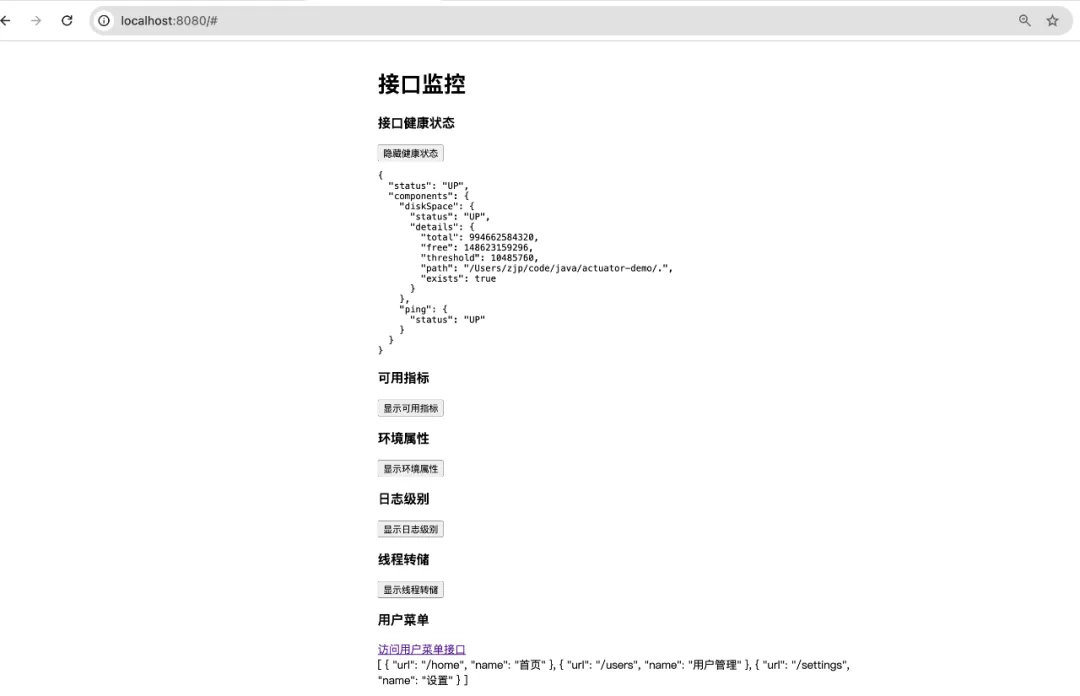超贊!Spring Boot 3.3 自帶 Controller 接口監控,大家趕緊用起來
在現代應用開發中,系統的實時監控和維護變得至關重要。Spring Boot 3.3 的 Actuator 模塊為開發者提供了一整套強大的監控功能,使得應用程序的健康狀況、性能指標、用戶行為及安全性得以全方位掌握和管理。本文將詳細介紹如何配置和使用 Actuator,并展示如何將這些監控數據在前端頁面中可視化。
Spring Boot 3.3 的 Actuator 模塊提供了一整套全面的監控功能,幫助開發者更好地管理和維護應用程序。主要功能包括:
- 健康檢查:實時監控應用的健康狀態,快速發現和處理系統問題,確保應用穩定運行。
- 性能指標:監控應用的性能數據,如請求處理時間和響應時間,幫助識別和解決性能瓶頸。
- 環境屬性:展示應用的環境配置信息,為調試和環境管理提供支持。
- 請求追蹤:記錄和分析 HTTP 請求的詳細信息,幫助追蹤和定位問題源頭。
- 日志管理:動態調整日志級別,方便進行問題排查和監控。
- 線程轉儲:提供 JVM 線程的詳細轉儲信息,幫助分析線程狀態和優化性能。
這些功能使得開發者能夠實時獲取應用的運行狀態,優化系統性能,提升用戶體驗,并增強系統的安全性。接下來,我們將展示如何配置 Actuator 及其功能,并如何在前端頁面中展示這些監控數據。
運行效果:
 圖片
圖片
若想獲取項目完整代碼以及其他文章的項目源碼,且在代碼編寫時遇到問題需要咨詢交流,歡迎加入下方的知識星球。
項目依賴配置
首先,確保你的 pom.xml 文件中包含 Actuator 和 Thymeleaf 的依賴。
<?xml versinotallow="1.0" encoding="UTF-8"?>
<project xmlns="http://maven.apache.org/POM/4.0.0" xmlns:xsi="http://www.w3.org/2001/XMLSchema-instance"
xsi:schemaLocation="http://maven.apache.org/POM/4.0.0 https://maven.apache.org/xsd/maven-4.0.0.xsd">
<modelVersion>4.0.0</modelVersion>
<parent>
<groupId>org.springframework.boot</groupId>
<artifactId>spring-boot-starter-parent</artifactId>
<version>3.3.3</version>
<relativePath/> <!-- lookup parent from repository -->
</parent>
<groupId>com.icoderoad</groupId>
<artifactId>actuator-demo</artifactId>
<version>0.0.1-SNAPSHOT</version>
<name>actuator-demo</name>
<description>Demo project for Spring Boot</description>
<properties>
<java.version>17</java.version>
</properties>
<dependencies>
<!-- Spring Boot Starter Web -->
<dependency>
<groupId>org.springframework.boot</groupId>
<artifactId>spring-boot-starter-web</artifactId>
</dependency>
<!-- Spring Boot Actuator -->
<dependency>
<groupId>org.springframework.boot</groupId>
<artifactId>spring-boot-starter-actuator</artifactId>
</dependency>
<!-- Thymeleaf for HTML templates -->
<dependency>
<groupId>org.springframework.boot</groupId>
<artifactId>spring-boot-starter-thymeleaf</artifactId>
</dependency>
<dependency>
<groupId>org.springframework.boot</groupId>
<artifactId>spring-boot-starter-test</artifactId>
<scope>test</scope>
</dependency>
</dependencies>
<build>
<plugins>
<plugin>
<groupId>org.springframework.boot</groupId>
<artifactId>spring-boot-maven-plugin</artifactId>
</plugin>
</plugins>
</build>
</project>配置 Actuator 監控功能
在 application.yml 中配置 Actuator 端點,啟用所需的監控功能。
server:
port: 8080
management:
endpoints:
web:
exposure:
include: health, metrics, info, mappings, env, conditions, loggers, threaddump
endpoint:
health:
show-details: always
metrics:
enable:
all: true
info:
enabled: true
mappings:
enabled: true
env:
enabled: true
conditions:
enabled: true
loggers:
enabled: true
threaddump:
enabled: true
trace:
http:
enabled: true創建 Actuator 監控 Controller
創建一個 MonitoringController,用于展示 Actuator 的監控數據。
package com.icoderoad.actuator_demo.controller;
import org.springframework.boot.actuate.env.EnvironmentEndpoint;
import org.springframework.boot.actuate.health.HealthEndpoint;
import org.springframework.boot.actuate.info.InfoEndpoint;
import org.springframework.boot.actuate.logging.LoggersEndpoint;
import org.springframework.boot.actuate.management.ThreadDumpEndpoint;
import org.springframework.boot.actuate.metrics.MetricsEndpoint;
import org.springframework.web.bind.annotation.GetMapping;
import org.springframework.web.bind.annotation.RequestMapping;
import org.springframework.web.bind.annotation.RestController;
import java.util.HashMap;
import java.util.Map;
@RestController
@RequestMapping("/monitoring")
public class MonitoringController {
private final HealthEndpoint healthEndpoint;
private final MetricsEndpoint metricsEndpoint;
private final InfoEndpoint infoEndpoint;
private final EnvironmentEndpoint environmentEndpoint;
private final LoggersEndpoint loggersEndpoint;
private final ThreadDumpEndpoint threadDumpEndpoint;
public MonitoringController(HealthEndpoint healthEndpoint, MetricsEndpoint metricsEndpoint,
InfoEndpoint infoEndpoint, EnvironmentEndpoint environmentEndpoint,
LoggersEndpoint loggersEndpoint, ThreadDumpEndpoint threadDumpEndpoint) {
this.healthEndpoint = healthEndpoint;
this.metricsEndpoint = metricsEndpoint;
this.infoEndpoint = infoEndpoint;
this.environmentEndpoint = environmentEndpoint;
this.loggersEndpoint = loggersEndpoint;
this.threadDumpEndpoint = threadDumpEndpoint;
}
@GetMapping
public Map<String, Object> getMonitoringData() {
Map<String, Object> monitoringData = new HashMap<>();
monitoringData.put("health", healthEndpoint.health());
monitoringData.put("metrics", metricsEndpoint.listNames());
monitoringData.put("info", infoEndpoint.info());
monitoringData.put("environment", environmentEndpoint.environment(null)); // 返回環境屬性描述符
monitoringData.put("loggers", loggersEndpoint.loggers());
monitoringData.put("threaddump", threadDumpEndpoint.threadDump());
return monitoringData;
}
}創建用戶菜單接口
創建一個新的接口 /menu,用于提供用戶菜單數據。
package com.icoderoad.actuator_demo.controller;
import java.util.List;
import java.util.Map;
import org.springframework.web.bind.annotation.GetMapping;
import org.springframework.web.bind.annotation.RequestMapping;
import org.springframework.web.bind.annotation.RestController;
@RestController
@RequestMapping("/api")
public class UserController {
@GetMapping("/menu")
public List<Map<String, String>> getMenu() {
// 模擬返回用戶菜單
return List.of(
Map.of("name", "首頁", "url", "/home"),
Map.of("name", "用戶管理", "url", "/users"),
Map.of("name", "設置", "url", "/settings")
);
}
}視圖控制器
package com.icoderoad.actuator_demo.controller;
import org.springframework.stereotype.Controller;
import org.springframework.web.bind.annotation.GetMapping;
@Controller
public class IndexController {
@GetMapping("/")
public String index() {
return "index";
}
}創建 Thymeleaf 模板
在 src/main/resources/templates 目錄下創建或更新 monitoring.html 文件,以展示 Actuator 監控數據和測試接口結果。
<!DOCTYPE html>
<html lang="en">
<head>
<meta charset="UTF-8">
<meta name="viewport" content="width=device-width, initial-scale=1.0">
<title>接口監控</title>
<link rel="stylesheet" >
<script src="https://code.jquery.com/jquery-3.6.0.min.js"></script>
<style>
.container {
width: 40%;
margin: 40px auto;
}
pre {
white-space: pre-wrap; /* Allow text to wrap within the element */
word-wrap: break-word; /* Break long words */
}
</style>
</head>
<body>
<div class="container mt-5">
<h1>接口監控</h1>
<!-- 接口健康狀態 -->
<div class="mt-3">
<h3>接口健康狀態</h3>
<button class="btn btn-info" onclick="toggleContent('health', fetchHealth)">顯示健康狀態</button>
<pre id="health" style="display: none;"></pre>
</div>
<!-- 可用指標 -->
<div class="mt-3">
<h3>可用指標</h3>
<button class="btn btn-info" onclick="toggleContent('metrics', fetchMetrics)">顯示可用指標</button>
<pre id="metrics" style="display: none;"></pre>
</div>
<!-- 環境屬性 -->
<div class="mt-3">
<h3>環境屬性</h3>
<button class="btn btn-info" onclick="toggleContent('environment', fetchEnvironment)">顯示環境屬性</button>
<pre id="environment" style="display: none;"></pre>
</div>
<!-- 日志級別 -->
<div class="mt-3">
<h3>日志級別</h3>
<button class="btn btn-info" onclick="toggleContent('loggers', fetchLoggers)">顯示日志級別</button>
<pre id="loggers" style="display: none;"></pre>
</div>
<!-- 線程轉儲 -->
<div class="mt-3">
<h3>線程轉儲</h3>
<button class="btn btn-info" onclick="toggleContent('threaddump', fetchThreadDump)">顯示線程轉儲</button>
<pre id="threaddump" style="display: none;"></pre>
</div>
<!-- 用戶菜單 -->
<div class="mt-3">
<h3>用戶菜單</h3>
<a href="#" class="btn btn-primary" onclick="fetchUserMenu()">訪問用戶菜單接口</a>
<div id="menu-result" class="mt-2"></div>
</div>
</div>
<script>
function fetchMonitoringData() {
fetch('/monitoring')
.then(response => response.json())
.then(data => {
// Store the data in the global scope for later use
window.monitoringData = data;
})
.catch(error => console.error('Error fetching monitoring data:', error));
}
function fetchHealth() {
if (!window.monitoringData) {
fetchMonitoringData();
return;
}
return JSON.stringify(window.monitoringData.health, null, 2);
}
function fetchMetrics() {
if (!window.monitoringData) {
fetchMonitoringData();
return;
}
return JSON.stringify(window.monitoringData.metrics, null, 2);
}
function fetchEnvironment() {
if (!window.monitoringData) {
fetchMonitoringData();
return;
}
return JSON.stringify(window.monitoringData.environment, null, 2);
}
function fetchLoggers() {
if (!window.monitoringData) {
fetchMonitoringData();
return;
}
return JSON.stringify(window.monitoringData.loggers, null, 2);
}
function fetchThreadDump() {
if (!window.monitoringData) {
fetchMonitoringData();
return;
}
return JSON.stringify(window.monitoringData.threaddump, null, 2);
}
function fetchUserMenu() {
fetch('/api/menu')
.then(response => response.json())
.then(data => {
document.getElementById('menu-result').textContent = JSON.stringify(data, null, 2);
})
.catch(error => console.error('Error fetching user menu:', error));
}
function toggleContent(id, fetchFunction) {
const content = document.getElementById(id);
const button = event.target;
if (content.style.display === 'none') {
// Display content
content.textContent = fetchFunction();
content.style.display = 'block';
button.textContent = `隱藏${button.textContent.substring(2)}`;
} else {
// Hide content
content.style.display = 'none';
button.textContent = `顯示${button.textContent.substring(2)}`;
}
}
// Trigger fetchMonitoringData on page load
window.onload = function() {
fetchMonitoringData();
}
</script>
</body>
</html>運行并測試
- 啟動 Spring Boot 應用程序。
- 訪問 http://localhost:8080 頁面,查看 Actuator 提供的監控數據。
- 點擊“訪問用戶菜單接口”按鈕,查看用戶菜單接口的響應數據。
通過以上步驟,你可以輕松驗證 Actuator 的 HTTP 請求追蹤功能,并在頁面上測試用戶菜單接口。這樣不僅能夠展示 Actuator 的強大功能,還可以檢查和調試接口的響應數據。這篇文章希望能幫助大家有效地實現和利用 Spring Boot 的監控功能,并提升系統的管理和維護能力。







































